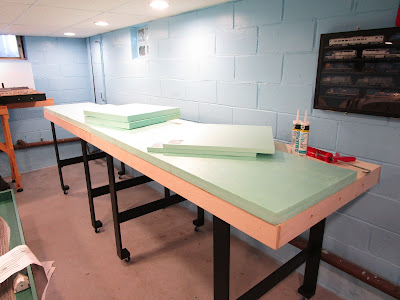This blog will be a record of my personal journey in researching, building, operating, and finally sharing my freelance O scale, three rail layout based on the railroads of New England.

Thursday, October 31, 2024
Installing cork roadbed
Thursday, October 24, 2024
Initial track plan ideas
Thursday, October 17, 2024
Benchwork: insulation foam
I topped the plywood with 2" thick extruded insulation foam, which is common place now for layouts. It is extremely light and strong and it is easily carved. This is important as I want to model the rolling terrain so common in New England.
Unfortunately, I own a small SUV so I had to cut the 4x8 sheet up in the Lowes parking lot with a knife and metal yardstick. The people driving through must have thought I was crazy. I searched everywhere for foam handy panels (2x4) but they don't seem to make them anymore. But it all arrived home safe. I needed 36 square feet, but a 4x8 sheet yields only 32, so I purchased a few extra 1" thick 2x2 panels that I can laminate together.
I used DAP acrylic caulk with silicone to attach the foam, laying down generous beads and spreading them out with a putty knife. Two tubes wasn't enough but I had a leftover half-tube on my paint shelf so I used that too. I still ran out and had to buy another tube, which still wasn't enough, and I finally grabbed some other caulk from my supply to finish the job.
I used some heavy weights to hold pieces down and did it in stages over the course of the day (because of the numerous hardware store runs for caulk) and it went pretty quick.
I needed the ends to be perfectly square and flush because additional layout sections would be joining up (concerns that wouldn't apply if I was building a large solid table top) so I cut up my foam into squares and did the ends first, then filled in with other pieces.
The back required a long strip that was about a foot thick. All of this resulted in numerous gaps which I attempted to fill with foam scraps.
Scenery will hide it all so it isn't a big deal, but I decided not to fill them in further with Sculptamold or "Ground Goop" at this time. I plan to use a foam cutter to sculpt the foam and it probably won't go through any hard binders so I will wait.
Then, I gave it a clean slate so to speak by painting it a dirt brown color that I matched at the store to the actual dirt I plan to use.Thursday, October 10, 2024
Benchwork: plywood tops
There are several good reasons to use thick plywood for layout baseboard construction, though it comes at the tremendous cost of money and weight. Another school of thought advocates for 1" or 2" insulation foam (pink or blue) alone as a baseboard, but that has its drawbacks too such as it is tough to mount things to the underside of it and trains running on it can be noisy.
I wanted my layout sections to be lightweight, relatively strong, and easily modified for scenery. I don't need my layout to support my weight and I don't plan to walk on it. Nor am I concerned about it sagging between the cross braces. So, I went with a combination approach: plywood and foam.
The first layer is some thin sanded 1/4" plywood. This ties the wood framing materials together and it easily bonds to the top of open-grid benchwork with wood glue. So, after going to several big box stores to purchase plywood (it took several to find a store with a working saw to cut it 3'x6' so that it would fit in my car) I brought it home. I laid it on top of the my benchwork and marked the location of the joists with yardstick.
Then, I applied a layer of wood glue to the top of every joist and around the edges and set the plywood on top, being careful not to slide it around or it would squeeze the wood glue out of the joints. Finally, I used 1" long panel nails to hold everything until the glue fully set. I didn't use screws because they would require pre-drilling every hole or else run the risk of splitting the plywood box frame.
The only casualty was a brand new T-shirt that got wood glue on it when I leaned over the benchwork to nail on the far side.
No matter how I skewed it, the plywood wasn't a perfect rectangle and it extended slightly over the benchwork edge. This could cause interference with future layout sections and it had to be removed. A power sander would make quick work of it but I didn't want to get sawdust all over everything. So, I clamped my yardstick to the edge and used a utility knife to cut away the offending plywood. Since it was only 1/4" thick, it was easy.
Next to come is the foam.




















